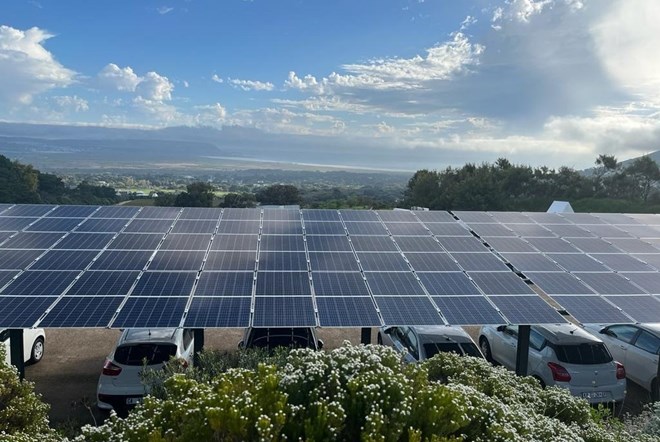
Sunday April 30, 2023
By Conrad Onyango
 Solar PV carports / Lameez Omarjee
Solar PV carports / Lameez Omarjee
For the past two decades, many rural homes in Africa have relied on solar home systems to meet their basic power needs, like lighting a few bulbs, charging the family's mobile phones and powering small appliances like radios and televisions.
Now, larger off-grid systems known as mini-grids (MGs), capable of powering bigger appliances - like fridges, flour and maize mills and even welding equipment - are increasingly being installed in rural communities.
"The mini-grid space continues to attract a lot of attention from development partners... There are already many MGs in operation and many more to come," the Africa Solar Industry Association said in its latest analysis.
The recent commissioning of more than 60 solar-powered mini-grids in the Kolda region of southern Senegal is just one example.
The Senegalese Rural Electrification Agency (ASER) 300 project targets the provision of MGs to more than 300 villages by 2024. The mini-grids have the capacity to power streetlights, refrigerators, millet and peanut-shelling machines and water pumps.
In March, development financier the African Development Bank (AfDB) Group approved a $28.49 million grant to help the Ghanaian government install 35 solar mini-grids to power 400 schools, 200 health centres, and 100 community energy service systems.
The AfDB is supporting similar projects in Madagascar, Kenya, Tanzania and Niger through its Climate Investment Funds (CIF) under its Scaling Up Renewable Energy Programme (SREP) in low-income countries.
Mini-grid initiatives are increasingly being led by private investors. In the Democratic Republic of the Congo, electricity access provider Nuru Sasu has begun courting international investors to help it develop a larger solar mini-grid project with a 35 megawatt (MW) peak capacity, targeting a population of 230 000.
Already, the energy firm has received a $1.5 million investment from a consortium of international investors to develop an installed capacity of 13.7 MW in the country's three cities of Goma, Kindu and Bunia.
"Nuru is delighted to have partners like REPP, Proparco and E3 Capital giving us the means to provide life-changing energy access in an extremely challenging environment," said Nuru's co-founder and CEO, Jonathan Shaw.
In January, a Madagascar renewable energy firm, WeLight, received €19 million Euros ($20.85 million) from a consortium of foreign investors, including the multi-lateral European Investment Bank (EIB), to support a$30 million solar MG project.
The project targets a population of about 250 000 in 120 villages that will see WeLight double its coverage area in the country from eight to 17 regions.
"This project continues the EIB's longstanding backing of off-grid solar energy in rural Africa, following successful projects in Benin, Chad, the Comoro Islands, Mozambique and Uganda," EIB vice-president Ambroise Fayolle said in a statement.
To date, WeLight successfully operates 40 villages in Madagascar and Mali, with plans to be present in Four African countries by 2023, it said on its website.
"WeLight aims to replicate this approach on more than 200 new sites by 2023," said the firm.
Kenyan financial service firm CrossBoundary Energy Access and France's ENGIE Access plan to invest $60 million to reach a population of 150 000 in Nigeria, indicating that investment deals are now also multi-regional.
Also, in March, the United Nations Development Programme (UNDP) announced the extension of its African Mini-Grid Programme (AMP) to Burkina Faso with an investment of €1.6 million ($1.75 million) towards the development of solar mini-grids over the next four years.
The initiative, already launched in Somalia and Nigeria, targets far-flung areas of 21 African countries.
In February, Kenya announced plans to set up 136 solar mini-grids as part of the World Bank's $150 million programme.
According to Kenyan Energy Cabinet Secretary Davis Chirchir, the country has 62 fully operational mini-grids and 28 others still under construction that will help the country achieve universal access to electricity by 2030.
The Rural Electrification Agency of Nigeria also recently announced plans to add 51 hybrid mini-grids following the successful deployment of 12 solar-mini grids in rural areas.
In November 2021, Nigerian energy firm HUSK Power announced plans to put up more than 100 solar mini-grids in the country by 2023 and 500 by 2026.
The World Bank has acknowledged the acceleration of deployment and is looking to ensure the trend continues.
"This is the result of falling costs of key components, the introduction of new digital solutions, a large and expanding cohort of highly capable mini-grid developers and growing economies of scale," said the authors of the 2019 report, Mini-Grids for Half a Billion People: Market Outlook and Handbook for Decision Makers.
While mini-grids are on track to provide the least power access cost - $0.20/kWh by 2030 - installation needs to be accelerated if all of Africa's rural areas are to receive electricity.
The World Bank points out that current rates will only see 12 000 new mini-grids installed by 2030, reaching only 46 million people at a cost of $9 billion.
The handbook projects that more than 160 000 mini-grids are needed at the cost of $91 billion to connect 380 million people in Africa.